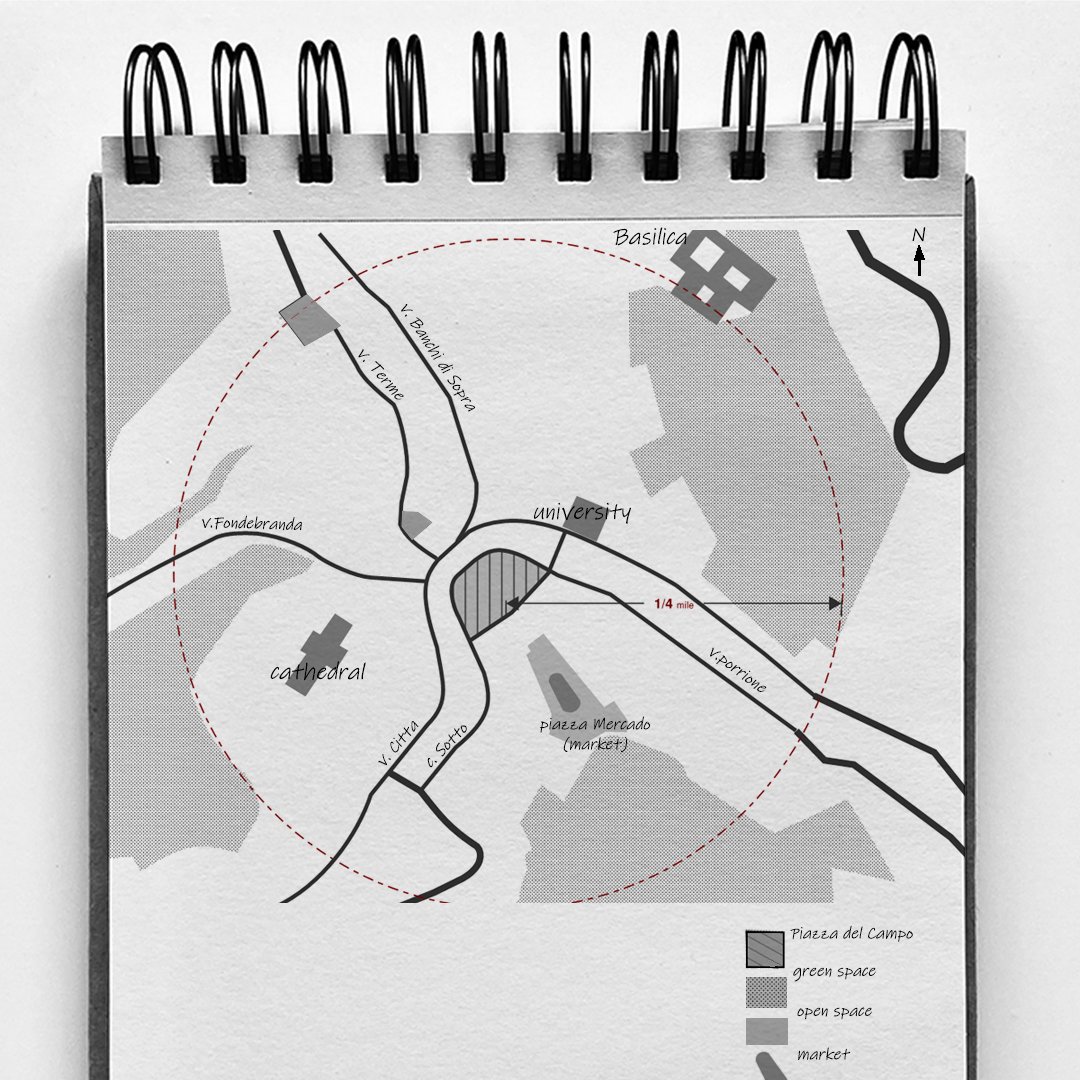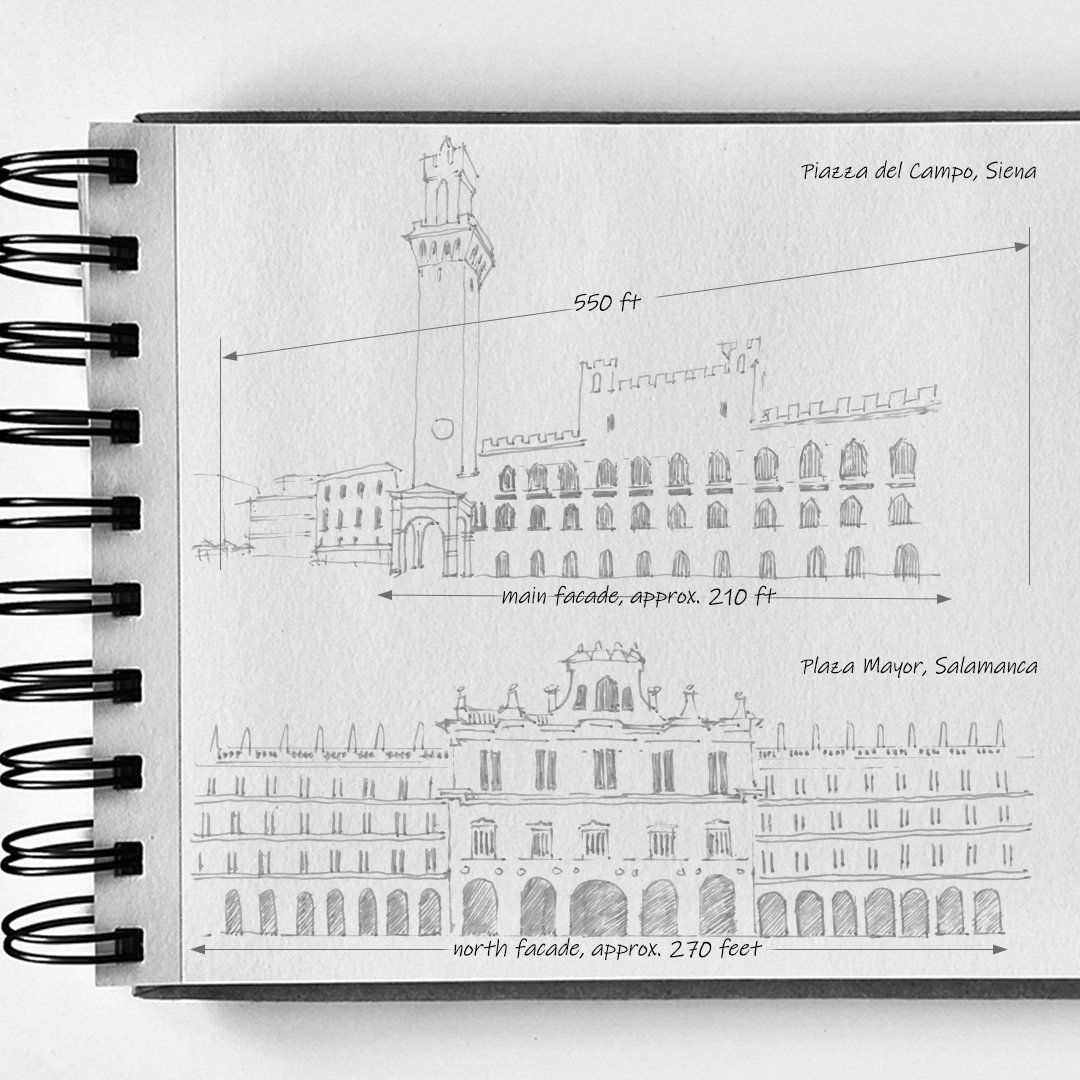Historically open spaces were designed to have activities and events. Here are a couple of famous examples.
Piazza Del Campo, Siena
Built in 1349, Piazza del Campo is the most important open space of Siena, Tuscany region in Italy. Before the thirteenth century, It was established as a marketplace on a sloping site adjacent to Palazzo Pubblico. The shell-shaped plaza was paved with fishbone-patterned red brick and eight lines of travertine which divided the plaza into nine sections.
The plaza was centered around the Pubblico Palace. Its Torre del Mangia watched over the plaza. Tower's slender and outstanding figure not only serves as a wayfinding landmark for the town but also functions as a large-scale sundial. It cast shadows on the plaza so that people were conscious of the time.
Because Siena is a hill city, the streets tend to form a circle around the terrain. The higher elevation of this town also made it seem more sacred; thus, we can see more religious institutes, the cathedral, the basilica, and the monastery within this small hill area. The hill characteristic also made the roads curve and turns to connect to the new development.
Traditionally, a horse race is held around the edge of the plaza twice a year. The plaza began serving as the finish point of the annual road cycling race (Strade Bianche) in 2007. To this day, Piazza del Campo remains the city's focal point of public life.
Plaza Mayor, Salamanca
The City of Salamanca in Spain is known as a historic university town. UNESCO declared the City of Salamanca a World Heritage Site in 1988. Its Plaza Mayor is the largest plaza in the city. As the core of the old town Salamanca, the plaza connects the shopping area at Calle del Toro on the northeast, the restaurants' area at Calle de Zamora and Calle Concejo on the northwest, and other streets on the south lead to Plaza Colón.
Built in the traditional Spanish baroque style, with shops on the ground floor, Plaza Mayor has been Salamanca's community living room: from the original bullfighting establishment in 1755 till today's plaza cafes. On the approximate 270 feet by 270 feet open space, Spaniards enjoyed their evening walk, people-watching, and university tuna performance. (1)
In this larger scale map, we can tell the town of Salamanca was surrounded by the street: N630, Ave de Mirat, and Paseo de Canalejas. These streets used to form the boundary of the old town of Salamanca, and the plaza mayor happened to be the center within 1/4 mile walking distance.
Paradigm of Quality Open Spaces
Human beings have a retirement age, and building and structures have their expected lifecycle. However, those plazas are still considered the paradigm in our modern time regardless of their centuries-old age.
Here are the reasons why they are considered the role model of today's open spaces (2):
Directly accessible to a street
Open to the public from sunrise to sunset.
Building facades facing the open space have windows for at least 60 percent of the façade.
The space is wide enough to accommodate multiple activities and events.
Open spaces surrounded customer-facing businesses (from restaurants, ice cream stores, souvenir shops, and jewelry stores to pharmacies, etc.)
A signature feature looked over the plaza. At Piazza del Campo, that means the Torre del Mangia and the Fonte Gaia. At Salamanca's Plaza Mayor, that means the bell tower on the top of the city hall.
Can We Repeat European Experiences In Modern America Cities?
It might be hard to move the horse race or the university’s tuna performance to an American city, but there are still look-and-feel characters we can imitate. Here are some good examples discovered in modern cities.
What's similar?
They are both in the heart of the neighborhood and connect to the major arterials. There are focal features in the open space; it is the movie screen at Strawberry Park and the Bell Tower, and the performance pavilion on the Rockville town square. All the shops and stores face the lawn to make the space active.
What's different?
These two squares have more intimate scales in a dense urban neighborhood compared to Piazza del Campo and Plaza Mayor. Town Square and Strawberry Park are in narrower shape (rectangular and trapezoid), making a solid central axis along the open space. Sizewise, they are about half of the plazas' size discussed above. That makes people inside the square feel more intimate rather than having awe towards the surrounding buildings.
Image on the left is Rockville Town Square, and the image on the right is Strawberry Park in Mosaic District. Both images are under the same scale.
What's Next?
A growing population will move to the urban area in the following decades; it might be more challenging to keep those open spaces at a sensible yet grand-scale. Thus, we might reconsider how big the open space is sufficient for the neighborhood. We also have to consider the open space's allocation to maintain and keep a good density for a reasonable investment return.
Questions such as our expectations of "open space" will also be rethought. Many of us have this preconceived notion that "open space" and "parks" are interchangeable. Some are convinced that only green space would provide a health benefit to the city and its residents. With hindsight, hardscapes such as Boston City Hall Plaza inevitably received criticism regardless of its recessed fountain, tree planters, and umbrella-shaded table.
Please don't mistake this article as an advocate for hardscape open space or European-nostalgic aesthetics, as we all learned the heat-island effect or the importance of permeable surfaces for stormwater management. However, Presenting these cases could help us look at many vacant lots in our city differently. Some vacant lots are odd and irregular-shaped, and some are not for the public, but they are all "open spaces." If we draw classic wisdom from these historic towns, we can develop our senses and understanding of existing hardscapes, plazas, or squares and find the beauty of using them creatively.
Notes and References:
For the centuries, the university’s students earned money to fund their education by signing in Salamanca’s plaza. “Tuna” refers to a vagabond student lifestyle. This 15th- to 18th-century tradition survives today as groups of students, dressed in the traditional black capes and leggings, sing and play mandolins and guitars, serenading the public in the bars, and walk around the Plaza Mayor. See how tuna group look like.
According to Commercial Residential and Employment Zones guidelines, there are ten necessary criteria to qualify as a quality open space (page 54-55). This article only selects characteristics based on the example plaza.
Article about the lifestyle in Mosaic District. See “The pieces have all come together in Fairfax’s Mosaic District“ from The Washington Post, 1.9.2020.
For readers interested in this topic, consider similar topics in this video, "Does Your City Have Enough Parks." That introduces multiple dimensions of the city park's planning and social impact.








